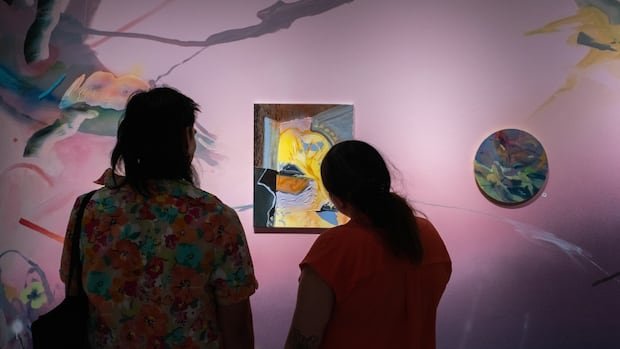It has been nine years since Colorado painter Pard Morrison showed his work in Denver, though it is clear that he saved up a lot of thought-provoking ideas for his return.
In some ways, the work in his current solo exhibit, “Everywhere You Go Love,” will be familiar to the many fans who remember the artist when he was a fixture at Rule Gallery back in the day. Morrison still thinks in straight lines and right angles. His signature move of creating multi-colored grids on flat surfaces remains at the center of his pictures.

Morrison has always been heavily influenced by the geometric abstraction movement of the 20th century — he’s a disciple of Agnes Martin — though he has long managed to carve his own distinguishable path through that overly-appropriated terrain. He brings it up to date using high-tech paint applied to aluminum, rather than the usual oil or acrylic on canvas.
Still, in other ways, the work feels very fresh. Part of that is because he is well-matched with his new art dealer, Robischon Gallery in the LoDo neighborhood, which has just the sort of tall and expansive exhibition space Morrison’s work needs to shine. This show only has nine objects but it feels sprawling.
There is plenty of room for both the two-dimensional wall pieces on display and a new series of paintings done on 10-foot-tall columns that Morrison custom fabricates. The columns, which look like a field of totems decorated on all sides with blocks of color, play out as something in between painting, sculpture and, because of their large scale, architecture.
Morrison also has an evolved attitude in his work, and that is the thing that really makes it new. I’ve always thought of his objects as formal and rigid, a bit cold at times. That was his calling card in the eyes of many admirers.
Now he is more mature, not just in years, though that is true, but also apparently somewhere in his soul, too. The recent work is softer, more human. It is less intimidating, and warmer.
A viewer has to look hard to see all that niceness. From far away, these works look like they rolled off an assembly line. They appear exacting, too perfect to be made with real hands. The decorative pattern looks to be calculated with a level of precision that only a quantum computer could devise.

The materials are intimidating, as well. Morrison’s media of choice is Fluoronar, a protective coating commonly used on boats and the cranes that lift cargo at marine ports. Indeed, Morrison’s works hold up indoors or outdoors; weather cannot destroy them.
Up close, everything changes. Morrison, in his new, not-so-fussy period, lets his lines loosen up, the blocks of color are not always aligned, and the application of color is uneven, a bit splotchy. Turns out, these objects are not so perfect after all.
That move allows these grids to take on a whole new personality. They look to be made with care and, yes, even love, as the show’s title suggests. I would not go so far as to say they are impressionistic, but there is definitely a free hand at work in their creation. These talismans, at first so static, are revealed to be dynamic.
That imbues them with a kind of personal agency that machine-made objects lack, and it puts the emphasis on the choices that the artist made during production. Why these patterns? Why these colors, which sometimes complement one another and other times seem to insult one another?
And where do the patterns start and stop? Is what we see on the canvas — or the aluminum — the whole picture, or has Morrison captured just a section of a grid that goes on for eternity and this is all he could fit into the space at hand?
Moreover, what are we looking at? Not a clear image, for sure. But something richer. Perhaps Morrison is painting that ephemeral place in our advanced world where hand-made and machine-made intersect. That space where realness collides with possibility.
He invites us to dive into this matrix in multi-dimensional ways, and to imagine, as a society, where we go from here. And he suggests we move in a positive direction. Consider the titles of his works: “Bright Morning Star,” “Beauty from the Ashes,” and the column-shaped centerpiece of the exhibit, “Everywhere You Go Love.” We get the message.

I cannot close out this review without giving a nod to the other work currently on view at Robischon, a five-person show called “Parallels.”
Each of the artists in this exhibit — painters Don Voisine, Marilyn McNeil, Deborah Glotsky and Kate Petley, and sculptor Linda Fleming — all do their own personal magic combining geometric shapes and pools of rich color to spark viewer’s imaginations.
Each artist has his or her own style — soft, hard, fluid, flat or folded — but they mostly rely on distinct lines or grids to make their points.
That makes the show a suitable companion to Morrison’s solo, and makes yet another time when Robischon, the most thoughtful commercial gallery in Denver, has found a way to connect the artists on its roster together and create a well-curated moment of art viewing.
Ray Mark Rinaldi is a Denver-based freelance writer specializing in fine arts.
IF YOU GO
“Everywhere You Go Love” and “Parallels” continue through Oct. 5 at Robischon Gallery, 1740 Wazee St. Free. Info: 303-298-7788 or robischongallery.com.






